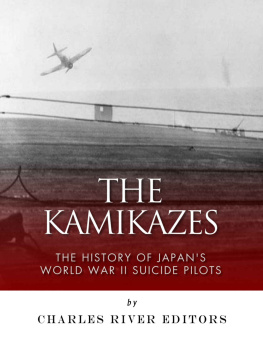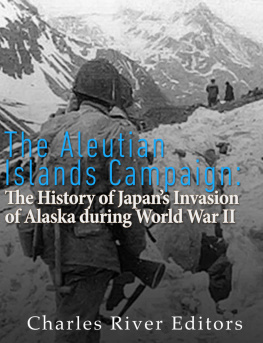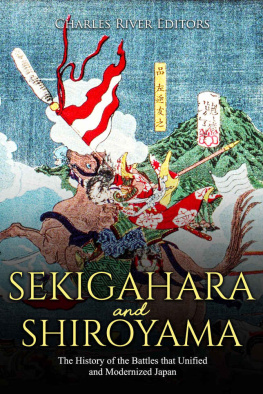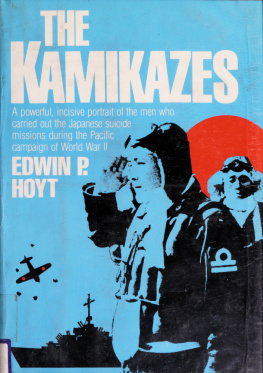Charles River Editors - The Kamikazes: The History of Japan’s World War II Suicide Pilots
Here you can read online Charles River Editors - The Kamikazes: The History of Japan’s World War II Suicide Pilots full text of the book (entire story) in english for free. Download pdf and epub, get meaning, cover and reviews about this ebook. year: 2014, publisher: Charles River Editors, genre: Romance novel. Description of the work, (preface) as well as reviews are available. Best literature library LitArk.com created for fans of good reading and offers a wide selection of genres:
Romance novel
Science fiction
Adventure
Detective
Science
History
Home and family
Prose
Art
Politics
Computer
Non-fiction
Religion
Business
Children
Humor
Choose a favorite category and find really read worthwhile books. Enjoy immersion in the world of imagination, feel the emotions of the characters or learn something new for yourself, make an fascinating discovery.
- Book:The Kamikazes: The History of Japan’s World War II Suicide Pilots
- Author:
- Publisher:Charles River Editors
- Genre:
- Year:2014
- Rating:5 / 5
- Favourites:Add to favourites
- Your mark:
- 100
- 1
- 2
- 3
- 4
- 5
The Kamikazes: The History of Japan’s World War II Suicide Pilots: summary, description and annotation
We offer to read an annotation, description, summary or preface (depends on what the author of the book "The Kamikazes: The History of Japan’s World War II Suicide Pilots" wrote himself). If you haven't found the necessary information about the book — write in the comments, we will try to find it.
The Kamikazes: The History of Japan’s World War II Suicide Pilots — read online for free the complete book (whole text) full work
Below is the text of the book, divided by pages. System saving the place of the last page read, allows you to conveniently read the book "The Kamikazes: The History of Japan’s World War II Suicide Pilots" online for free, without having to search again every time where you left off. Put a bookmark, and you can go to the page where you finished reading at any time.
Font size:
Interval:
Bookmark:
By Charles River Editors

Picture of the USS Bunker Hill being hit by a kamikaze during the Battle of Okinawa on May 11, 1945

Charles River Editors provides superior editing and original writing services across the digital publishing industry, with the expertise to create digital content for publishers across a vast range of subject matter. In addition to providing original digital content for third party publishers, we also republish civilizations greatest literary works, bringing them to new generations of readers via ebooks.
Sign up here to receive updates about free books as we publish them , and v isit Our Kindle Author Page to browse todays free promotions and our most recently published Kindle titles.

Picture of a kamikaze hitting the USS Essex on November 25, 1944
Kamikazes
Do you desire earnestly/wish/do not wish to be involved in the Kamikaze attacks? A Japanese survey question for Special Flight Officer Probationary Cadets
I felt the moment of transition from life to death approaching me minute by minute. I gave up my effort to sleep and let my thoughts wander around. My short life of 21 years is going to switch to the world of death tomorrow. Some vague thoughts about my soul being enshrined in Yasukuni Shrine, about the incomprehensive world of death, and other thoughts came and went. I thought there were more things I wanted to do in my life, but then I wasn't sure what it was that I wanted to do. I didn't know what, but I was certain there was still much that I had left to do here. I felt embarrassed to realize that I was still so attached to life after all this time. What a coward! Shame on myself! I would say to myself So are you ready now? and there was a self that would answer Yes sir! I'm ready to go, but there was still another self who never stopped yelling I don't want to die!" Japanese pilot Goro Nagamine, March 1945
One of the most fascinating aspects of World War II was Japans use of suicide pilots known around the globe as kamikazes, though the Japanese referred to them as Tokubetsu kgekitai (Special Attack Units). Translated as God Wind, Divine Wind and God Spirit, kamikazes would sink 47 Allied vessels and damage over 300 by the end of the war, but the rise in the use of kamikaze attacks was evidence of the loss of Japans air superiority and its waning industrial might. This method of fighting would become more common by the time Iwo Jima was fought over in early 1945, and it was especially prevalent during the invasion of Okinawa in April 1945. The privilege of being selected as a kamikaze pilot played directly into the deep-seated Japanese mindset of death before defeat. The pilot training manual assured each kamikaze candidate that when they eliminated all thoughts of life and death, fear of losing the earthly life can be easily overcome.
Still, not all cases of those chosen to be kamikazes were equally noble. Recruits were trained with torturous regimens or corporal punishment, and stories of mental impairment caused by drugs or saki abound. Some were described as tottering and dazed, being carried to their planes by maintenance officers, and forcibly pushed in if they backed down. Pilots who could not find their targets were told to turn around and spare their own lives for another day, but if a pilot returned nine times, he was to be shot. At the moment of collision, he was instructed to keep his eyes open at all times, and to shout Hissatsu (clear kill).
Altogether, nearly 4,000 kamikaze pilots died in combat between October 1944 and August 1945, and about one in seven managed to hit his target. At their peak, they did far more damage to the American Navy than did conventional air attacks, and they undoubtedly placed a significant new obstacle in the path of the American forces slowly encircling the Japanese home islands. However, the widespread use of kamikaze tactics darkened and hardened attitudes toward Japan within the American military and helped to set the stage for the total war on Japanese civilians that the American military waged in the closing months of the war. The Marine Corps Gazette noted, The ruthless atrocities by the Japanese throughout the war had already brought on an altered behavior (deemed so by traditional standards) by many Americans resulting in the desecration of Japanese remains, but the Japanese tactic of using the Okinawan people as human shields brought about a new aspect of terror and torment to the psychological capacity of the Americans. As one sailor aboard the USS Miami recalled about kamikaze attacks at Okinawa, "They came in swarms from all directions. The barrels of our ship's guns got so hot we had to use firehoses to cool them down."
The kamikazes were the most effective weapon the Japanese had in terms of sinking ships, but they only appeared in the final year of the war. The fact that Japans military leadership concluded it was both necessary and justified to establish special units of pilots trained to sacrifice their own lives by crashing their planes into enemy vessels was a mark of their own desperation. In the heat of battle, individual soldiers occasionally risked certain or near-certain death to protect their comrades or advance their mission, but organized unites devoted to suicide tactics were virtually unknown before 1944. They appeared only once the course of the war had turned decidedly against the Japanese.
The Kamikazes chronicles the history of Japans famous suicide pilots and explains when, why, and how Japan resorted to their use near the end of war. Along with pictures of important people, places, and events, you will learn about the kamikazes like never before, in no time at all.
To Masanori and Kiyoko,
Your father cannot be seen to your eyes, but he is always watching over you. Listen well to what mother tells you and don't make her worry. And when you grow up, take any profession you like, and become a respectable Japanese citizen. Don't be envious of your friends' daddies. Your Daddy, Masanori and Kiyoko, has become a god and is always watching you. You two study hard, and help your mother with her chores too. Masanori and Kiyoko, Daddy can't play horse with you anymore, but you two chum up and hang close to each other.
Your Daddy was a jolly fellow who got on board a big heavy bomber and wiped out the enemy. You two grow up and be as strong as Daddy, and please avenge my death. - Lt. Col. Masanobu Kuno, May 1945
The first organized, large-scale use of kamikaze tactics was in October 1944, during the battle of Leyte Gulf in the Philippines, but by this point, the Imperial Japanese Navy, and particularly its Air Service, was a shadow of its former self. In 1941, at the outset of the Pacific War, Japanese naval aviation was arguably the most formidable in the world; its pilots were the best-trained, its aircraft were the most technologically advanced, and its leadership was the most tactically sophisticated. Even in June 1942, the American Navy entered the decisive Battle of Midway at a distinct disadvantage, and luck and cunning, not superior technology or overwhelming force, won Midway for the Americans. From that point forward, however, as the United States began to exploit more fully its vast human and material resources, and as the conflict evolved into a grinding war of attrition of the sort that Japan was not suited to wage, Japans capacity to prosecute an air war against America declined precipitously. In June 1944, at the Battle of the Philippine Sea, with three fleet carriers sunk and perhaps 600 aircraft lost, the remnant of Japans Naval Air Service was decisively crushed.
Font size:
Interval:
Bookmark:
Similar books «The Kamikazes: The History of Japan’s World War II Suicide Pilots»
Look at similar books to The Kamikazes: The History of Japan’s World War II Suicide Pilots. We have selected literature similar in name and meaning in the hope of providing readers with more options to find new, interesting, not yet read works.
Discussion, reviews of the book The Kamikazes: The History of Japan’s World War II Suicide Pilots and just readers' own opinions. Leave your comments, write what you think about the work, its meaning or the main characters. Specify what exactly you liked and what you didn't like, and why you think so.



















